
Text by MARTIN WINDROW, Color plates by MICHAEL ROFFE. YEAR 1972
THE PANZER DIVISIONS
The armoured divisions which did so much to secure an unbroken chain of German victories in the first two years of the Second World War were a wholly new phenomenon on the world's battlefields. The terrible fruits of the foresight, determination and single-minded effort of a handful of brilliant soldiers, they were a new weapon forged for a new purpose and wielded in a new way. It was to be literally years before the Allies produced commanding generals who understood the full potential of this new weapon, and who grasped the vital rules for using it effectively. The formidable achievements of the Panzer arm are matched by a sort of fierce glamour which clings to their name, an image compounded partly of respect for the genuinely outstanding performance of this new breed of soldier in victory and in defeat, and partly of the dramatic appearance of his equipment and his uniform. Though basically practical, the black suit with its silver skull badges invites immediate comparison with the uniform of an earlier body of German shock-troops - the 'Death's-Head Hussars', the 'Black Brunswickers' of the nineteenth century.

Genesis - with cardboard and plywood 'tanks' the German Army of the 1930s practised the evolutions which would take them in triumph from the Arctic Circle to the Sahara, from the Atlantic to the Caspian. (Imperial War Museum)
In the present brief study it is impossible to offer a detailed history of the operations of this very large corps. The writer has limited himself, after careful thought, to a short account of the basic elements of the Panzer arm; a list of operational units, giving, in note form, details of formation, theatres of operation and component units, where known; and as full a commentary as possible on the uniforms and insignia ably illustrated by the artist. The temptation to follow fascinating trains of discussion concerning the armoured war in Europe, Africa and Russia has been resisted, with regret; so great a part did the Panzer units play in the changing fortunes of the Second World War that it would be all too easy to find oneself writing a general history of the whole conflict.
It should perhaps be made clear at this stage that this book deals only with the Panzer divisions of the German Army; those controlled by the Waffen-SS and the Luftwaffe are covered in two other titles by the present writer in the Men-at-Arms series: Waffen-SS and Luftwaffe Airborne and Field Units.
By 1930 there existed within the German Reichswehr a group of far-sighted senior officers to whom the limitations of the Treaty of Versailles presented a more galling frustration than to their colleagues.

Command version of the PzKpfw. I tank passes in review before Hitler and Mussolini; note the officer's parade aiguillettes. (Imperial War Museum)
Men such as Lutz, Guderian, von Reichenau and von Thoma were the 'tank enthusiasts'; the research of these keen students of the most advanced international theories of armoured warfare was seriously hampered by the ban which the treaty placed upon the production of heavy armoured vehicles in Germany. They were forced to mount experimental manoeuvres, exercises designed to familiarize their men with the tank, using such unsatisfactory expedients as motor cars carrying cardboard dummies of tank turrets. Undeterred by this handicap, these officers evolved a new philosophy of warfare, unsuspected by their past and future enemies, apart from a few exceptions, and by no means easily accepted by their colleagues.
The core of the Panzer theory was the idea of a highly mobile combat group of all arms - tanks, artillery and heavy infantry - which could strike at will across country. It would be controlled from the front, by generals riding with the armour; it would be supplied independently by its own rear echelon services; and it would be able to exploit local conditions to the full, without lengthy back- reference to higher command. There would be no need to hamper the advance of the group by the inclusion of lumbering heavy artillery - close liaison with the Air Force would provide an airborne artillery barrage.
The difficulties facing the tank enthusiasts were considerable, even when Adolf Hitler came to supreme power in Germany and became an enthusiastic convert. The industrial know-how, and the actual factory plant, required to produce modern armoured vehicles in quantity was not available, and had to be built up with painful slowness. There were blind alleys in the thinking-out of design which cost yet more time. True, when Germany began openly rearming in 1935 some of the obstacles to progress disappeared, but the equipment actually available when war was declared four years later still fell far short of the ideal envisaged by Guderian and his colleagues in the years of theoretical planning.
The first three Panzer formations were raised in October 1935. On paper each division was to have a complement of two tank regiments, of two battalions each, totalling 561 tanks; a lorry-borne infantry brigade; and strong motor-towed field and anti-tank artillery units. Engineers and signals troops, and motorcycle battalions for reconnaissance, completed the all-arms force. But the hard fact was that in 1935 only a handful of tanks had rolled from the factories, all of them of the light Mk. I and Mk. II classes. None the less, the apparently premature birth of the Panzer divisions gave the tank enthusiasts a framework to work with. The armoured build-up did not always proceed smoothly; many still clung to the old theory that tanks should be tied closely to the infantry, aiding and shielding their advance, while the cavalry branch decided to stake their claim to some of the production of the tank factories, and formed four light divisions, each requiring a light tank battalion. Over and over again the guardians of the new weapon had to press their arguments in favour of concentration; dispersed among infantry and glorified cavalry units, the tanks would be as good as useless. The essence of the whole plan was the launching of concentrated attacks by large independent armoured formations, capable of overwhelming the enemy at any one point. It was known that the Western democracies, on the other hand, favoured the 'dispersal' policy.
In the years leading up to the outbreak of war the new divisions slowly evolved. The infantry element was increased, and the tank element cut down. Useful combat experience was gained by the 'instructors' sent to assist Franco in the Spanish Civil War; vehicles were in too short supply to practise the mass attack, but liaison techniques between armoured commanders and their air support were evolved, and polished. The rape of Czechoslovakia gave the desperately under- equipped tank arm a useful bonus in the form of more than 400 serviceable tanks and well- organized factories. Even so, when war broke out in September 1939 the six Panzer divisions on the establishment were still much weaker than they should have been. Of more than 3,000 tanks in service or reserve, the Germans had only 98 of the medium Mk. IIIs and 211 of the powerful Mk. IVs.

PzKpfw. II tanks in winter scenery, possibly during the occupation of Norway. Note that the commanders wear ordinary Army field-grey greatcoats over their uniforms. (Imperial War Museum)
The new force had another weapon, however - a weapon which the Allies were never to acquire in so full a measure: superbly trained and selected crews. Unlike other armies, who treated the armour as just another branch of the forces, the Germans selected their tank crews exclusively from among the most promising recruits. These were instilled from the start with a fiercely professional pride and determination, and were encouraged, not least by their dramatic black uniforms, to think of themselves as an elite. They were trained to a high level, many learning at least two of the basic trades of the tank soldier - driver, gunner and radio operator - and were exercised under semi-operational conditions during Germany's bloodless invasions of the Sudetenland and Czechoslovakia.
Their equipment, although in short supply, was excellent. The little PzKpfw. I (Panzerkampfwagen = armoured combat vehicle) was useful in a scouting role, though not for much else. The PzKpfw. II, with its 20 mm gun, was light but not excessively so by contemporary standards. The PzKpfw. III, with a 37 mm main armament, and the PzKpfw. IV, mounting a 75 mm gun, were formidable.
Lightning War: September 1939 - November 1941
The invasion of Poland offered the green Wehrmacht perfect conditions for learning the finer points of the art of aggression under fire. The disparity in total forces committed was not great; in armour it was astronomical, since against Germany's six new divisions the Poles could field only a weak brigade of obsolete tanks. Most of the German divisions were committed to the southern prong of the triple assault, and in less than a month, crucified by the Wehrmacht and the Red Army together, Poland lay at the mercy of her conquerors. But her agony had taught the German tank generals some sharp lessons.
It became clear that tanks could often turn strong defensive positions by launching wide 'hooks' through weakly defended 'untankable' terrain such as thick woodland. If they fought by the book - stopping when they encountered strong opposition, trying to burst through by sheer gun-power, probably suffering heavy casualties, pulling back while the infantry mounted set-piece attacks - then their greatest advantage was lost. By immediately dashing on in a slightly different direction, and refusing to accept that country was impassable until they had actually tried to drive through it and failed, not only could specific positions be turned, but the enemy's whole rhythm and pace of defence could be thrown into confusion. A corollary was the discovery that a single troop of tanks appearing in the enemy's rear from an unexpected direction could create greater disruption than a whole battalion advancing down the expected route.
While the secret of success appeared to lie in leaving the bulk of the infantry behind and striking on without pause, many of the 217 tank casualties suffered by Germany in Poland were due to the lack of an armoured cross-country vehicle in which the Panzer grenadiers could keep right up with the forward tank elements; this lack had already been pointed out by Guderian. In their vulnerable trucks the infantry of the Panzer Korps - the perfect armoured corps was now seen to be two Panzer and one motorized division - tended to hang back from the point of actual contact. While they could forget the bulk of the marching infantry, the tanks badly needed their own mobile shock-troops. Many incidents occurred in which a delayed response by the infantry led to tank casualties and to delay in the clearing of an obstacle which could have been swept aside at little cost, had immediate infantry support been given.
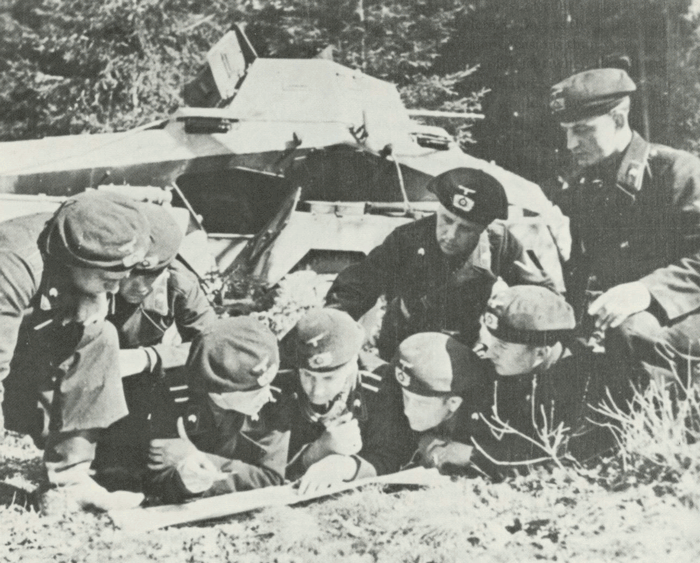
Men of an armoured reconnaissance unit - 'Panzer Aufklärungs Abteilung' - study maps beside an SdKfz. 232 8-rad armoured car. The loose black beret or Schutzmütze, worn over a rubber skull-protector, was with drawn in favour of the sidecap in the winter of 1939/40; among collectors it is the most sought-after of all German military headgear. (Imperial War Museum)
The provision of half-tracks for the Panzer-grenadiers would continue throughout the war, but never fast enough; fully armoured divisions were never achieved. Another danger to the Panzers was commitment to street fighting - again, a lesson which was learnt but never fully applied. In three hours' fighting in the narrow confines of the Warsaw suburbs, 4th Panzer Division, unable to vary their line of attack, set up like sitting ducks for determined Polish gunners dug into the rubble, lost 57 out of 120 tanks committed. Other failures in the campaign were the horsed cavalry and semi-mechanized light divisions - the former outmoded, the latter suffering the inevitable penalty of being neither fish nor fowl. In the immediate aftermath of the campaign, the four light divisions were converted to full Panzer division establishment.
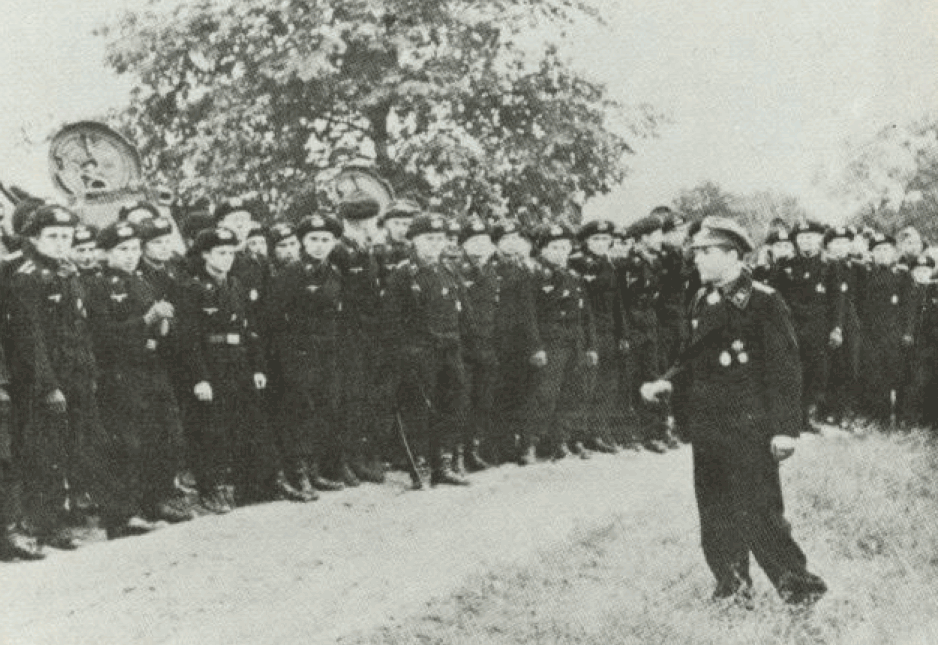
Company briefing for a Panzer unit equipped with the Czech-built PzKpfw. 35t tank, almost certainly a sub- unit of the 6th Panzer Division. The black berets suggest that this picture was taken in 1939, and the combat decorations worn by the officer indicate that the Polish campaign was already over. The captain wears his 'old-style officer's field cap' instead of a beret; he is a Ritterkreuzträger (holder of the Knight's Cross) and wears the Panzer Assault Badge and the silver Wound Badge below the Iron Cross 1st Class on the left breast. (Imperial War Museum)
Finally, the inevitably high ratio of tanks dropping out of action at any one time through mechanical failure was underlined in the latter weeks of the fighting. At the outset an acceptable figure of 25 per cent was recorded; in the last stages of the campaign the high mileage travelled under combat conditions had taken so severe a toll that virtually every vehicle needed overhaul.
In the West the German successes in Poland provoked only short-sighted reactions; the myth that the film of the Panzer divisions on their victory ride was posed with 'cardboard tanks' was still surprisingly widespread, and in many quarters the victory was attributed to equipment which, though fairly limited, was more modern in character. With a tank strength greater in numbers than that of the Germans, the Allies were still wedded to the old idea of light 'cavalry' tank formations spread thinly along the line of defence, and heavy 'infantry' tanks split up among the foot-sloggers in small groups; fatally, they did not seek superiority at any one point. In the spring of 1940 they were finally taught their error, and those surprisingly strong elements in the German High Command who still distrusted the new wonder-weapon were silenced once for all.
The Allies expected any attack to come through Holland and northern Belgium, roughly following the coastal strip before turning south through Amiens and Paris. This had been planned by the Oberkommando Wehrmacht, based on the old Schlieffen Plan of the First World War. But after Poland, von Mannstein (with the delighted support of the 'tank enthusiasts') proposed an attack through the 'impassable' terrain of the Ardennes in southern Belgium, sweeping west and north to the coast - trapping the Allies' best mobile troops in the 'pocket', where he proposed to lure them by a conventional but secondary attack through the Low Countries.
Put briefly, this is what happened in May-June 1940; and this, despite material deficiencies in the Panzer force. Of 2,687 tanks on the strength in May, only 627 were PzKpfw. IIIs and IVs; 381 were Czech PzKpfw. 38t types, and the remainder were light PzKpfw. Is and lis. France mustered about 3,000 machines, of which nearly half were gathered in light mechanized and armoured divisions (D.L.M.s and D.C.M.s) and the rest were dispersed among the infantry. The B.E.F. had 210 light and 100 heavy tanks, all committed to infantry support; 174 light and 156 'cruisers' of the 1st Armoured Division awaited shipment from the U.K. Quality varied; while the guns and armour of the best French types were well up to, or superior to, German equipment, the practice of mounting the commander alone in the turret, doubling as the gunner, cut the efficiency of the French tanks badly. The British heavy tanks, especially the handful of new Matildas, were more than a match for any Panzer; unfortunately control procedures were far too complex and unwieldy.
By smooth teamwork, unflagging advance, and maximum disruption of the enemy rear, the Panzer arm had in five weeks smashed a road to the sea, and to victory. By 25 June the Wehrmacht were in control of the whole of France north of a line roughly from Angoulême to Clermont-Ferrand, Lyon and the Swiss frontier at Geneva. There is no space here for a detailed commentary on the campaign. The Allied armour, fatally dispersed, was cut into pockets by attackers who always enjoyed superiority at the point of engagement. The Germans fully exploited their air superiority. The technical superiority of the best Allied tanks was more than neutralized by local weakness in numbers, by the early failure of supply and communications as the German tanks rampaged through the Allied rear echelons, and by the general bewilderment which quickly gripped the Allied command structure at most levels.
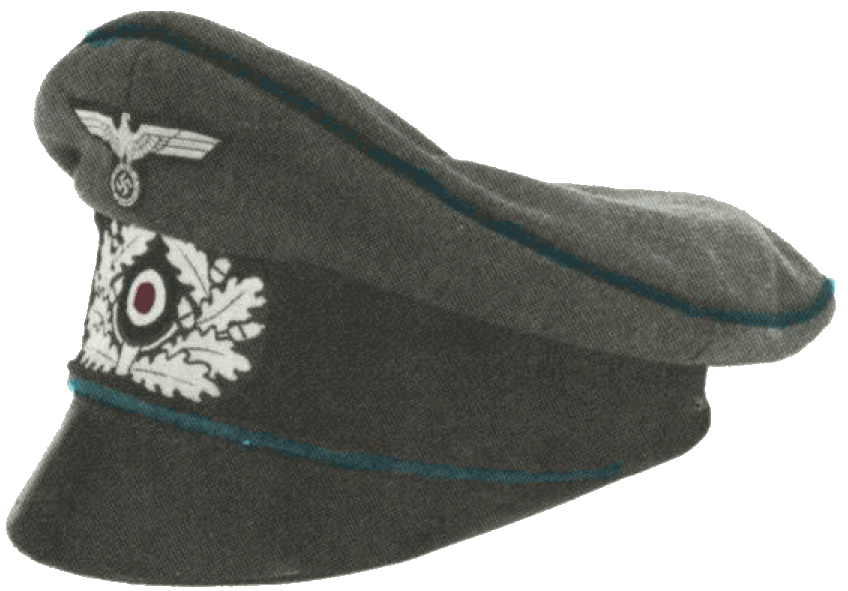
Old-style officer's field cap, with flat woven badges in silver on green, soft leather peak, and no cords or chin-strap. The Waffenfarbe piping on this example is cornflower blue, indicating a medical officer. (Author's collection)
July 1940 found the Panzertruppen the heroes of the hour. Theirs had been the breakthrough, and their Führer's enthusiasm took the form of demands for twice as many of these unique formations. Thus quantity began to take precedence over quality even at this early stage - the seeds of disaster were being sown. The need for crosscountry transport for the Panzer grenadiers was once more high on the list of priorities; so was the improvement of the tank guns and armour, which had shown up less than brilliantly on the few occasions when the Panzers met Allied Matildas or Char Bs on equal terms. (The 3-ton half-track personnel-carrier produced to answer the needs of the armoured infantry was to become the most numerous armoured vehicle built by Germany during the war; production figures of roughly 350 in 1940, and 950 in 1941, grew to no less than 7,800 in 1944.) The PzKpfw. III underwent a programme of up-gunning with a 50 mm weapon, and the armour of the PzKpfw. III and IV was increased. The demand for twice as many divisions meant that the tank strength of each would have to be halved; yet each required the full complement of secondary vehicles, increasing the strain on an industry already taxed by the programme of motorization in the infantry formations. The reorganization of the Wehrmacht in preparation for the attack on Russia was also hampered by the diversion of forces to Greece and North Africa, in order to pull Italy's chestnuts out of the fire.
When Operation Barbarossa opened in June 1941, some twenty Panzer divisions formed the spearhead of the German Army; of these, fourteen contained a single tank regiment of two battalions, and six fielded three tank battalions. The establishment of a battalion was about 90 tanks; so, allowing for 25 per cent mechanical failure at any time - a conservative estimate - Guderian's original figure of 560-odd tanks per division had now shrunk in practical terms to about 135. Total tank strength was about 3,200. Facing them were up to 20,000 Soviet tanks, but the sum was less stark than this figure suggests. While excellent T-34 and KV-I machines were coming into service with reorganized armoured brigades, they were not yet numerous and their crews were nowhere near full operational efficiency. The bulk of the huge total was made up of obsolete types, and of the total sum 60 per cent were unserviceable at any one time - an eloquent testimony to the efficiency of the Red Army in 1941.
Between June and September 1941 the world was treated to the spectacle of the Wehrmacht cutting up the enormous Soviet forces into helpless, milling pockets and then extinguishing them one by one, while the tanks raced on into the East at speeds of up to 50 miles a day. There were problems, however, which the superficial impact of the early German victories hid from all but a prescient few. The mileages covered over often appalling roads were taking a fearful toll in terms of mechanical wear. The roads were nowhere as good as had been expected; and once the poor surface had been torn up by the first waves of tanks, the supply lorries had even more difficulty in following up the advance with the essential lifeblood of fuel and ammunition. Moreover, the constant bewildering movement of the tank divisions was all that kept them alive, strung out as they were in relatively small groups far behind vastly superior Soviet forces. Nevertheless, it looked as though the trick would work; despite the unease of a school of German generals who felt that the tanks should not expose themselves so much, but should wait for the slower-moving infantry, it seemed that the dashing leaders who had captured Western Europe in weeks would repeat their exploits in the vast emptiness of Russia.
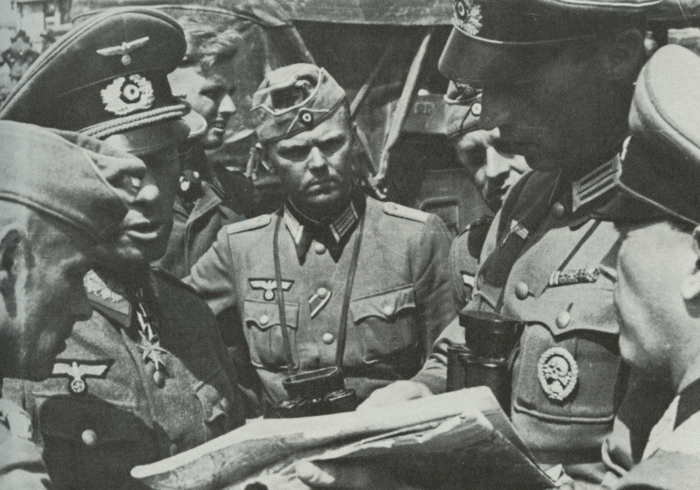
Group of 7th Panzer Division officers conferring during the campaign in the West, spring 1940. Second from left, partly obscured, is the divisional commander, General Erwin Rommel. Note early pattern Panzer Assault Badge worn by officer on right; this type, with the large death's-head motif, was authorized in 1936 by General von Thoma, commanding the tank units which fought in the Spanish Civil War. (Conway Maritime Press)
In the event, the juggler allowed a single ball to evade his grasp, and the whole structure came down about his ears. The decisive drive on Moscow had to be put off while the front was 'tidied up'. Large concentrations of Russian forces in the south had to be neutralized, and stiff resistance on the Leningrad front required a certain amount of redeployment. The Russians fell or were captured in their hundreds of thousands, in their millions - but still they fought on. The excellent new T-34S and KV-IS appeared in increasing numbers; often they were thrown away by unimaginative commanders, but where they were properly used they exacted a fearful price. By October, rain and mud heralded the approach of winter, and the push on Moscow presented far greater hazards than had faced the Wehrmacht in August. Progress was slow, fatally slow; and then the snows came down. The Russians were getting skilful at evading the pincers and harassing the faltering advance; and, above all, the tank divisions were exhausted. The supply of spares was inadequate, the narrow tracks of the Panzers were bogged down while the broad-tracked T-34S could still move at will, and the enormous distances already travelled had worn out men and machines; the mighty weapon became increasingly unserviceable. With the freeze-up came the inevitable counter-offensive by Zhukov's Siberian divisions, fresh, fit and accustomed to the terrible conditions.
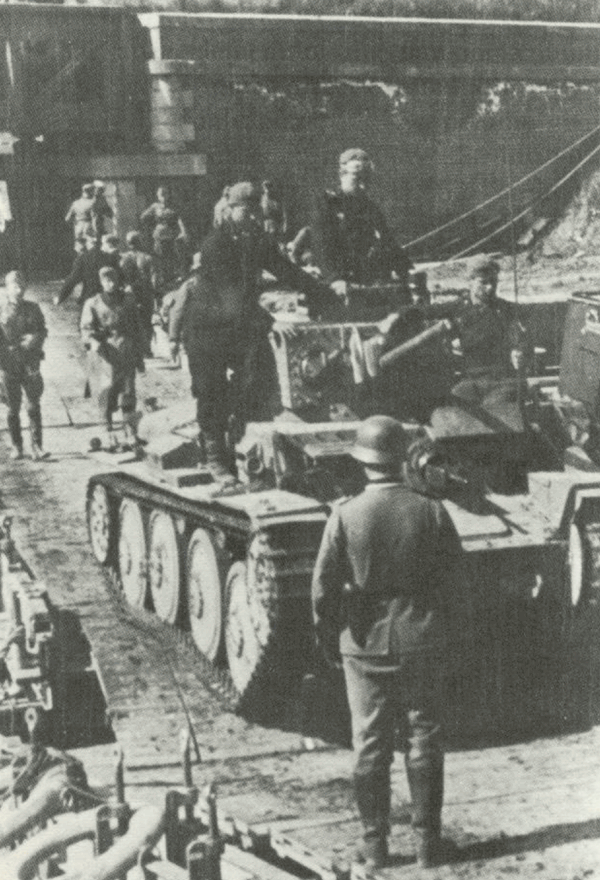
Czech-built PzKpfw. 38t Ausf. H tank of 7th Panzer Division crossing the La Bassée Canal, June 1940; of the 218 tanks in his division, Rommel had only some three dozen German-designed vehicles. Note that the crew wear black tank uniforms but grey sidecaps. The Schutzmütze had been withdrawn, but supplies of the black sidecap were not yet available for all personnel. (Conway Maritime Press)
The winter of 1941/2 saw the first great set-back of German arms. The wonder was that they survived it at all, but from now on the hallmark of the Wehrmacht was to be an incredible resilience in the face of repeated failure.

One of the few PzKpfw. III tanks of the 7th Panzer Division being guided on to a French beach at the end of the drive to St-Valéry, June 1940. Note large national flag draped over rear stowage for aerial recognition. (Conway Maritime Press)
We have much more interesting information on this site.
Click MENU to check it out!
∎ cartalana.com© 2009-2025 ∎ mailto: cartalana@cartalana.com